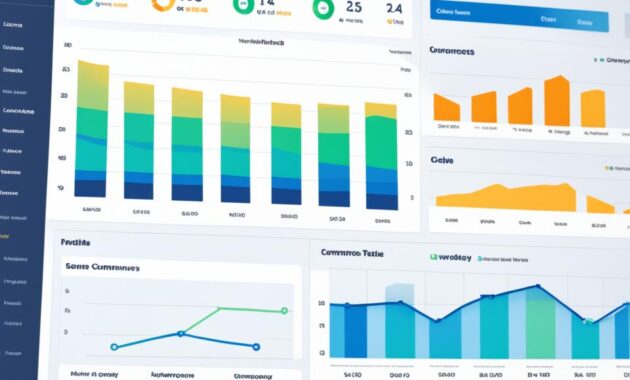In the current digital era, a well-constructed and user-centric e-commerce website is vital for any business aiming to excel online. It’s essential for both established retailers and budding entrepreneurs. A successful e-commerce site is the cornerstone for tapping into vast opportunities and boosting sales online.
This guide will dissect the fundamental elements and best practices for creating e-commerce sites that draw in customers, ensure a smooth shopping journey, and foster business expansion. We will examine the strategies and techniques necessary for your online store to shine in the digital sphere. This includes crafting a visually appealing and intuitive interface, and establishing a secure, dependable e-commerce platform.
Key Takeaways
- Understand the importance of creating a user-friendly e-commerce website that enhances the shopping experience
- Discover the essential components of a robust e-commerce platform to support your online business
- Learn effective marketing strategies, including search engine optimization (SEO) and social media integration, to attract and engage customers
- Ensure secure transactions and data protection to build customer trust and loyalty
- Leverage emerging technologies, such as artificial intelligence and augmented reality, to stay ahead of the competition
Crafting a User-Friendly E-commerce Website
In the competitive realm of online shopping, designing a user-friendly e-commerce website is paramount. Success hinges on crafting a seamless browsing and purchasing experience tailored to your audience’s needs and preferences.
Intuitive Navigation and Layout
An intuitive navigation system and a well-structured layout form the cornerstone of a successful e-commerce website. Customers should effortlessly locate products, navigate through the digital storefront, and complete their purchases without encountering obstacles.
- Organize your product categories and subcategories in a logical and hierarchical manner, making it simple for customers to browse and discover the items they need.
- Implement a clean and visually appealing design, with clear call-to-action buttons and intuitive user interfaces that guide customers through the shopping experience.
- Ensure your website’s search functionality is robust, allowing customers to quickly find specific products or browse based on various filters and criteria.
Optimized for Mobile Devices
In today’s digital landscape, a significant portion of online shopping occurs on smartphones and tablets. Optimizing your e-commerce website for mobile devices is imperative. A mobile-friendly design not only enhances the user experience but also boosts your website’s search engine visibility and rankings.
- Ensure your website is responsive, adapting seamlessly to different screen sizes and resolutions.
- Prioritize a clean, uncluttered mobile layout that prioritizes key features and minimizes unnecessary distractions.
- Optimize images, videos, and other media elements for fast loading times on mobile devices, as slow loading speeds can significantly impact user engagement and conversion rates.
By focusing on intuitive navigation, a well-structured layout, and mobile optimization, you can create an e-commerce website that delivers a truly user-friendly experience. This approach will drive increased traffic, engagement, and sales for your online business.
“Creating a user-friendly e-commerce website is not just about aesthetics, but about understanding the needs and preferences of your customers and designing an experience that caters to them seamlessly.”
Establishing a Robust E-commerce Platform
Building successful e-commerce websites hinges on the e-commerce platform you select. This pivotal choice significantly impacts the seamless operation and growth of your online retail hubs. It’s vital to weigh factors such as scalability, security, and compatibility with various tools and services when exploring e-commerce solutions.
Scalability is paramount when choosing an e-commerce platform. Even if your online venture begins modestly, it’s anticipated to expand. A scalable platform ensures your store can adapt to increased traffic, larger product offerings, and more intricate customer interactions without sacrificing performance or user experience.
Security is equally crucial for an e-commerce platform. Ensuring the protection of customer data, including payment and personal information, is paramount. Seek platforms that provide comprehensive security features, including SSL/TLS encryption, PCI-DSS compliance, and sophisticated fraud prevention tools. Such measures foster trust among customers and protect your e-commerce activities.
The capacity to integrate with diverse tools and services is another critical element in platform selection. Seamless integration with marketing, analytics, shipping, and CRM solutions enhances the shopping experience and optimizes business operations. This flexibility enables you to tailor your e-commerce solutions to the specific needs of your online retail hubs.
| Feature | Importance | Example Platforms |
|---|---|---|
| Scalability | High | Magento, WooCommerce, Shopify |
| Security | High | Shopify, BigCommerce, Squarespace |
| Integration Capabilities | High | Magento, Salesforce Commerce Cloud, Elastic Path |
By meticulously assessing these key factors and selecting an e-commerce platform that matches your business objectives, you lay a solid foundation for your online retail hubs. This strategic decision facilitates a seamless and secure shopping experience, setting the stage for the long-term success of your e-commerce endeavors.
“The right e-commerce platform can make all the difference in the success of your online business. It’s the backbone that supports your web-based stores and ensures a smooth, secure, and scalable shopping experience for your customers.”
Enhancing the Shopping Experience
In the realm of electronic commerce sites and internet retail portals, the shopping experience stands as a critical factor. E-tailers must focus on crafting an engaging and seamless experience to boost sales and cultivate loyalty.
Product Visualization and Descriptions
Offering customers a clear visual representation of your products is crucial. High-quality images, 360-degree views, and interactive visualizations aid in informed purchasing decisions. Detailed descriptions that spotlight key features, materials, and applications enhance the shopping experience. They empower customers to grasp the value of your offerings.
Streamlined Checkout Process
A smooth checkout process is vital for converting browsers into buyers. E-commerce sites should aim to reduce the steps to complete a transaction. They should provide various payment options and a user-friendly interface. Features like guest checkout, autofill, and clear progress indicators can notably improve the checkout experience. This reduces abandoned carts and elevates customer satisfaction.
“The key to success in the e-commerce industry lies in creating a shopping experience that is not only visually appealing but also seamlessly integrated from start to finish.”
By focusing on product visualization, detailed descriptions, and a streamlined checkout process, e-commerce sites and internet retail portals can enhance the shopping experience. This approach drives increased sales and customer loyalty.
Effective Marketing Strategies for E-commerce Websites
In the ever-evolving realm of e-commerce, the implementation of potent marketing strategies is paramount for augmenting traffic and conversions to your online storefront. By harnessing the capabilities of search engine optimization (SEO) and social media integration, e-commerce entities can significantly elevate their visibility, reach, and engagement with their target demographic.
Search Engine Optimization (SEO)
At the heart of a successful e-commerce marketing approach lies search engine optimization. This practice entails refining your website’s content, structure, and technical aspects to enhance its position on search engine results pages (SERPs). This, in turn, facilitates easier discovery by prospective customers. Techniques such as keyword research, on-page optimization, content creation, and link building are integral to this process. They collectively amplify your online presence and draw in a more targeted audience to your e-commerce platforms.
Social Media Integration
Integrating your e-commerce site with social media platforms serves as a potent strategy to expand your audience reach and foster deeper connections with customers. Platforms such as Facebook, Instagram, and Twitter offer avenues to display products, disseminate engaging content, and cultivate customer relationships. By leveraging social media’s vast reach and targeting precision, you can effectively promote your e-commerce sites, drive traffic, and cultivate brand allegiance.
By strategically combining SEO with social media integration, e-commerce entities can significantly bolster their marketing endeavors. This synergy leads to heightened visibility, elevated customer interaction, and, ultimately, increased conversions.
| Tactic | Benefits |
|---|---|
| Search Engine Optimization (SEO) |
|
| Social Media Integration |
|
“Effective marketing is not about interrupting people with ads, but about creating content so useful and meaningful that people actually want to engage with it.”
Ensuring Secure Transactions and Data Protection
In the fast-paced realm of e-commerce, the security and privacy of customer data are paramount. Online retail hubs must integrate dependable payment gateways and adhere to industry standards. This ensures customer trust and a secure shopping experience.
Payment Gateway Integration
Choosing an appropriate payment gateway is crucial for any online store. E-commerce solutions must assess factors like transaction speed, data encryption, and fraud detection. This ensures the safety of financial transactions. By collaborating with reputable payment service providers, online retailers can reduce risks such as chargebacks and data breaches, establishing trust with customers.
Compliance with Industry Standards
Adhering to standards like the Payment Card Industry Data Security Standard (PCI-DSS) is vital for e-commerce. These guidelines set the minimum requirements for secure handling of sensitive customer data, including credit card and personal information. Demonstrating compliance reassures customers their data is secure, crucial in the competitive e-commerce market.
Secure payment gateways and strict compliance with industry standards are key to a trusted e-commerce platform. By focusing on customer data safety, online retailers can build a loyal customer base and lead in the evolving e-commerce landscape.
Analyzing and Optimizing E-commerce Website Performance

In the ever-evolving realm of e-commerce, the continuous evaluation and refinement of your website’s performance are paramount for enduring success. Through the utilization of analytics and reporting tools, e-commerce entities can monitor pivotal metrics, pinpoint areas for enhancement, and execute data-driven strategies. These efforts aim to enrich the user experience and augment conversions across online shopping platforms and digital storefronts.
Website Analytics and Reporting
Comprehensive analytics furnish a treasure trove of insights, pivotal for strategic e-commerce decision-making. They enable the tracking of user behavior, traffic patterns, conversion rates, and shopping cart abandonment. This deep dive into customer interactions with your digital storefront equips e-commerce businesses with the knowledge to tailor their sites to better serve their online clientele.
Monitoring the bounce rate is a critical metric. It reflects the percentage of visitors who depart the site after viewing just one page. A high bounce rate often signals issues with navigation, content, or the overall user experience. Addressing these concerns can help retain visitor engagement and boost conversion rates.
Examining the performance of individual product pages sheds light on which items resonate with your audience. By discerning which products attract the most attention and generate substantial sales, e-commerce entities can strategically highlight these items. This approach enhances the shopping experience for customers, thereby strengthening their connection with the brand.
| Metric | Description | Importance for E-commerce Websites |
|---|---|---|
| Bounce Rate | The percentage of visitors who leave the site after viewing only a single page. | A high bounce rate may indicate issues with the website’s navigation, content, or user experience, requiring optimization to keep visitors engaged. |
| Conversion Rate | The percentage of visitors who complete a desired action, such as making a purchase. | Tracking conversion rates helps e-commerce businesses identify and address any obstacles in the shopping journey, ensuring a seamless experience that drives sales. |
| Average Order Value (AOV) | The average monetary value of each order placed on the e-commerce website. | Monitoring AOV can help e-commerce businesses implement strategies to increase the average size of customer orders, such as offering product recommendations or bundling deals. |
By harnessing the insights from analytics and reporting, e-commerce entities can make strategic decisions to refine their online platforms and storefronts. This approach ensures a superior customer experience and fosters sustainable growth for their ventures.
E-commerce Websites: Scaling for Growth
As your e-commerce business grows, ensuring a scalable platform and infrastructure is essential. Scaling necessitates strategic planning and the adoption of effective solutions to manage increased traffic, sales, and product offerings. This strategic approach is vital for sustaining growth and enhancing operational efficiency.
Expanding Product Offerings
Expanding your product range is a pivotal step in scaling your e-commerce site. It broadens your customer base and diversifies revenue streams. By selecting products that resonate with your audience, you can enrich your e-commerce solutions and boost customer interaction.
Optimizing Inventory Management
Effective inventory management is indispensable for scaling web-based stores. Utilize advanced inventory tracking systems, predictive models, and automated replenishment to maintain optimal stock levels. This strategy prevents stockouts, reduces excess inventory, and elevates operational efficiency.
Leveraging Cloud-based Technologies
As your online retail hubs expand, embracing cloud-based technologies is advisable for managing increased traffic and sales. Cloud-hosted platforms, content delivery networks, and scalable infrastructure offer the flexibility and scalability required to handle demand spikes and support expansion.
| Key Strategies for Scaling E-commerce Websites | Benefits |
|---|---|
| Expanding Product Offerings | Attracts a wider customer base and diversifies revenue streams. |
| Optimizing Inventory Management | Ensures product availability, minimizes excess inventory, and improves operational efficiency. |
| Leveraging Cloud-based Technologies | Provides flexibility, scalability, and the ability to handle increased traffic and sales. |
By adopting these strategies, you can effectively scale your e-commerce site to support your business’s growth and cater to a larger customer base.
“Scaling an e-commerce website is not just about increasing traffic and sales – it’s about building a sustainable, adaptable platform that can evolve with your business.” – Industry Expert, Jane Doe
Building Customer Loyalty and Retention
In the competitive world of electronic commerce sites and internet retail portals, cultivating customer loyalty and retention is paramount for success. By delving into the preferences and browsing patterns of individual customers, e-tailers can tailor product recommendations to meet their unique needs. This approach not only boosts repeat business but also fosters enduring customer engagement.
Personalized Recommendations
The strength of personalized recommendations lies in their capacity to offer tailored suggestions that blend seamlessly into the shopping experience. Through the application of data-driven insights into customer behavior, e-commerce platforms can provide product recommendations that resonate deeply with the customer’s interests. Such recommendations significantly enhance the shopping experience, thereby increasing the chances of successful conversions and repeat purchases.
Loyalty Programs and Rewards
Designing an effective loyalty program is a potent strategy for enhancing customer loyalty and retention. By offering rewards, incentives, and exclusive benefits to loyal customers, e-tailers can incentivize repeat purchases and cultivate a sense of belonging among their customer base. These loyalty programs, which can include reward points, exclusive discounts, or members-only perks, aim to fortify the connection between the customer and the e-commerce site.
By integrating personalized recommendations with loyalty-building initiatives, e-commerce platforms can craft a bespoke and engaging customer experience. This approach not only fosters long-term loyalty and repeat business but also underpins the overall success and expansion of the e-commerce site, securing its position in the competitive internet retail arena.
“Loyal customers are the lifeblood of any successful electronic commerce site. By understanding their needs and preferences, and providing them with a truly personalized shopping experience, e-tailers can build a lasting relationship that drives growth and profitability.”
Leveraging Emerging Technologies for E-commerce
The realm of e-commerce is undergoing a significant transformation, with forward-thinking online retailers at the forefront. They are harnessing emerging technologies to enhance customer engagement. Artificial intelligence (AI) and chatbots, along with virtual and augmented reality (VR/AR), are pivotal in reshaping the digital shopping landscape.
Artificial Intelligence and Chatbots
AI-powered chatbots have emerged as crucial tools for e-commerce sites, offering bespoke customer support and simplifying the shopping process. These intelligent virtual assistants can swiftly address customer queries, suggest products, and facilitate the checkout process. By tapping into AI’s capabilities, e-commerce platforms can provide a more streamlined and satisfying shopping experience. This, in turn, fosters customer loyalty and satisfaction.
Virtual and Augmented Reality
The advent of virtual and augmented reality is transforming how consumers engage with products online. E-commerce sites can now deliver immersive experiences, allowing shoppers to see products in their actual surroundings. This bridges the gap between online and physical shopping. Through virtually “trying on” clothing or exploring a gadget’s features, VR and AR enhance the shopping experience, boosting customer confidence and conversion rates.




